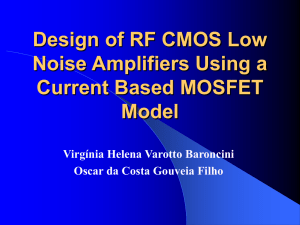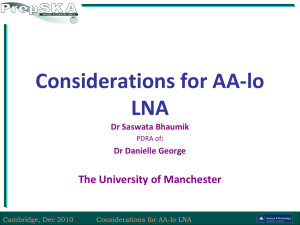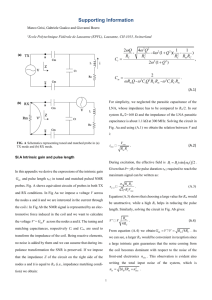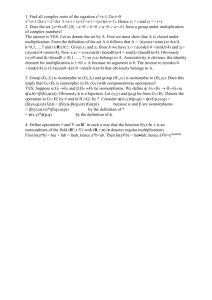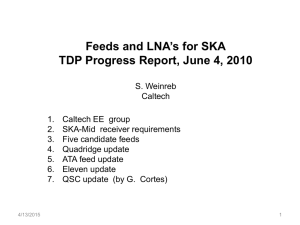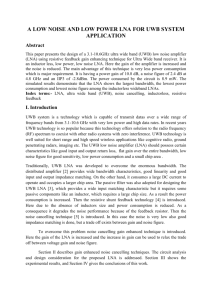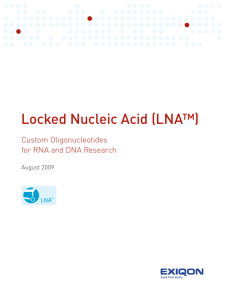switch_lna
advertisement
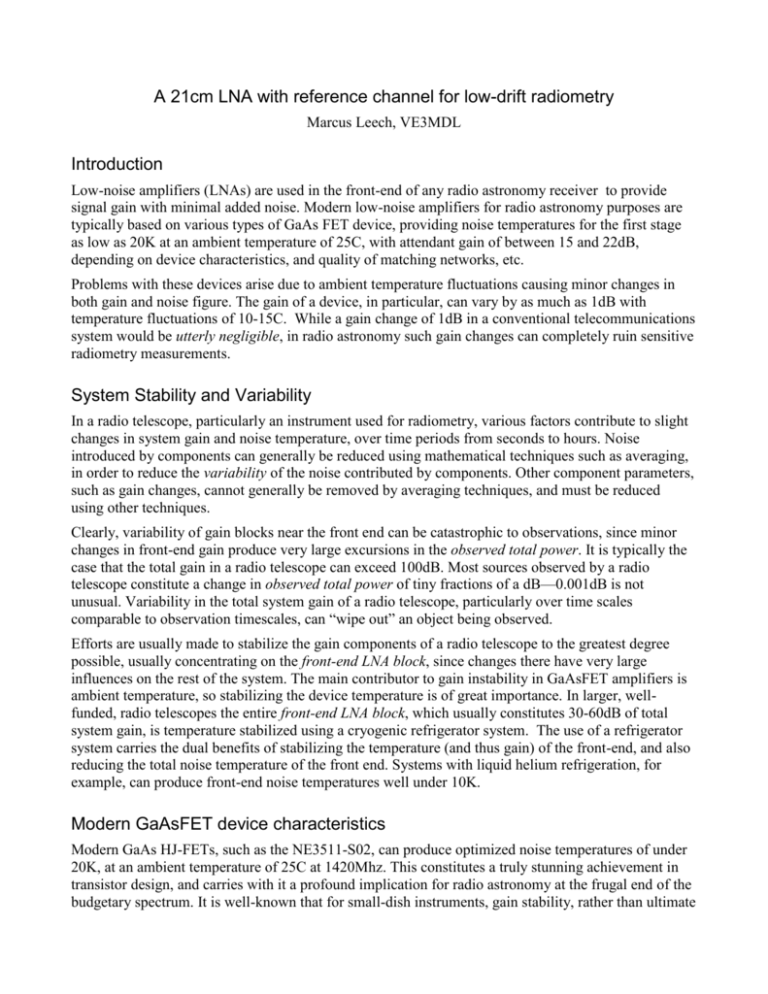
A 21cm LNA with reference channel for low-drift radiometry Marcus Leech, VE3MDL Introduction Low-noise amplifiers (LNAs) are used in the front-end of any radio astronomy receiver to provide signal gain with minimal added noise. Modern low-noise amplifiers for radio astronomy purposes are typically based on various types of GaAs FET device, providing noise temperatures for the first stage as low as 20K at an ambient temperature of 25C, with attendant gain of between 15 and 22dB, depending on device characteristics, and quality of matching networks, etc. Problems with these devices arise due to ambient temperature fluctuations causing minor changes in both gain and noise figure. The gain of a device, in particular, can vary by as much as 1dB with temperature fluctuations of 10-15C. While a gain change of 1dB in a conventional telecommunications system would be utterly negligible, in radio astronomy such gain changes can completely ruin sensitive radiometry measurements. System Stability and Variability In a radio telescope, particularly an instrument used for radiometry, various factors contribute to slight changes in system gain and noise temperature, over time periods from seconds to hours. Noise introduced by components can generally be reduced using mathematical techniques such as averaging, in order to reduce the variability of the noise contributed by components. Other component parameters, such as gain changes, cannot generally be removed by averaging techniques, and must be reduced using other techniques. Clearly, variability of gain blocks near the front end can be catastrophic to observations, since minor changes in front-end gain produce very large excursions in the observed total power. It is typically the case that the total gain in a radio telescope can exceed 100dB. Most sources observed by a radio telescope constitute a change in observed total power of tiny fractions of a dB—0.001dB is not unusual. Variability in the total system gain of a radio telescope, particularly over time scales comparable to observation timescales, can “wipe out” an object being observed. Efforts are usually made to stabilize the gain components of a radio telescope to the greatest degree possible, usually concentrating on the front-end LNA block, since changes there have very large influences on the rest of the system. The main contributor to gain instability in GaAsFET amplifiers is ambient temperature, so stabilizing the device temperature is of great importance. In larger, wellfunded, radio telescopes the entire front-end LNA block, which usually constitutes 30-60dB of total system gain, is temperature stabilized using a cryogenic refrigerator system. The use of a refrigerator system carries the dual benefits of stabilizing the temperature (and thus gain) of the front-end, and also reducing the total noise temperature of the front end. Systems with liquid helium refrigeration, for example, can produce front-end noise temperatures well under 10K. Modern GaAsFET device characteristics Modern GaAs HJ-FETs, such as the NE3511-S02, can produce optimized noise temperatures of under 20K, at an ambient temperature of 25C at 1420Mhz. This constitutes a truly stunning achievement in transistor design, and carries with it a profound implication for radio astronomy at the frugal end of the budgetary spectrum. It is well-known that for small-dish instruments, gain stability, rather than ultimate noise temperature is a significant factor in determining an instruments ultimate sensitivity and repeatability. Most GaAsFET devices have a noise figure that is sensitive to ambient temperature, but the penalties for running devices at a higher ambient temperature are quite modest. It is typical that a 25C increase in ambient temperature of a device increases its noise temperature by less than 5K. The NE3511, for example, increases noise temperature from roughly 20K to about 25 to 28K when the ambient temperature is raised to 50C from 25C. In big-budget radio astronomy, telescope time is at a premium, so that using long integration times to reduce effective noise temperature (proportional to the square-root of the integration time) isn't always feasible—in such situations, having a front-end with absolutely the lowest-achievable noise temperature means that sensitivity can be increased without resorting to long integration times. In contrast, small-budget radio astronomers can little afford the exotic refrigeration gear that is used to achieve the outstanding sensitivities of larger, well-budgeted instruments. Partial compensation can be had at the cost of longer integration times on smaller instruments. For example, changing the integration time (all else being equal) from 10s to 120s increases sensitivity by a factor of nearly 3.5 for the same overall system noise temperatures (Tsys). Heating instead of cooling Big budget radio astronomers might heartily-guffaw at the notion of heating an LNA in order to provide gain stability, but for smaller observatories with smaller budgets, heater-based stabilization can be achieved cheaply and reliably, at a very-modest cost in sensitivity (due to minor increases in Tsys). The advent of so-called PTC, or Positive Temperature Coefficient heaters means that complex control circuits for heater control aren't necessarily required in order to heat a device to a specific temperature. It would be nearly-trivial to bond one or more heater modules to the mechanical substrate of an LNA in order to provide uniform, and stable, heating to a desired temperature. Such PTC heaters have good temperature regulation, and when combined with “passive” temperature-stability techniques, can provide very good temperature (and thus gain) control of an LNA. Passive stabilization, in concert with active temperature control can be combined to produce an excellent LNA platform. An LNA mounted on a heavy aluminum block, with the addition of EPS foam insulation can be very resistant to ambient temperature changes, and thus disasterous gain changes. Dicke Switching Very early in the history of radio astronomy, it was recognized that overall system gain stability played a crucial role in realizing the theoretical sensitivity of a radio telescope. By using the work of Robert Dicke, a solution was arrived at in providing repeatable, highly-stable radiometer results. The action of a so-called Dicke switch is quite simple. The entire receiving chain, including the first LNA block, is constantly switched between a stable reference signal (usually a cold resistive load), and the so-called sky signal coming from the antenna. By doing this, any gain changes in the system are seen by both the reference signal and the sky signal. What that means is that the common part can be removed, either in analog hardware, or by (with modern receivers) digital means, usually in software. A significant problem with Dicke Switching, is that the signal switching mechanism necessarily must not introduce any significant loss in the signal path before the first LNA block—a requirement of less than 0.05dB is not unheard of—the reason for this is that any loss in front of the first LNA block adds directly to that blocks noise figure. In big-budget instruments, the switching mechanisms are very high-end, and thus very costly, but they produce excellent insertion-loss characteristics. For lower-budget astronomers, there's not a lot of RF switching hardware that has all the desirable characteristics, including reliability, insertion-loss, and total lifetime. While SPDT RF relays do exist with fairly-low insertion loss (0.1dB), they cannot be switched at high rates and expected to last very long, since relays have lifetimes of perhaps a few million operations. That would be acceptable were it not for the fact that Dicke Switching requires that the input be switched at rates of a least 10s of cycles per second. Semiconductor switches, based on PIN diodes, are cheap, have excellent lifetimes, and switch very quickly. Unfortunately, there aren't any switches based on PIN diodes that have insertion losses that are anywhere near acceptable for use in front of a first LNA block. PIN-diode switches often have insertion losses of between 1.0dB and 3.0dB, which completely eliminates them for use in front of the first LNA block. Dual-channel LNA Several years ago, an amateur radio astronomer, Hans Michlmayr1, constructed a Dicke-Switched receiver front-end that is based on the principle of a dual-channel LNA, with one of the LNA channels serving as a reference channel. While his front-end had no thermal management at all (and thus, no gain management), tests performed on the dual-channel LNA showed very promising results, with the Sun, Cygnus A, Sagittarius A, the Moon, and M17 all used as test objects. Significant improvements in baseline drift were observed, even with ambient temperature variation of as much as 15C over the course of a solar transit. In Hans' design, the switching function occurs after the first low-noise gain stage, using matched GaAsFET devices both for the sky and reference channels. The rough theory behind this technique, which appears to be true in practice, is that while the two LNA devices may have slightly-dissimilar absolute gain and noise figure characteristics, they will follow very-nearly the same curve with respect to temperature response, and thus the reference channel very closely follows the sky channel. Combining high-temperature stabilization with a dual-channel architecture An obvious, and likely fruitful, follow-on to Hans Michmayr's work would be to combine the dualchannel switched architecture, with active temperature control of the entire LNA assembly, up to roughly the first 45-55dB of gain. By combining the approach, a strong synergistic effect can be achieved to produce a radiometer with high repeatability and stability. In Hans' design, there was no temperature stabilization, including for the reference load, which would have changed its noise temperature in direct proportion to the ambient temperature. Despite this drawback, Mr. Michlmayr's design achieved significant results. In a design with temperature stabilization (and in this case, high-temperature stabilization), the first 4555dB of front-end gain, along with the reference load on the reference channel, can be made very gainstable. Combining this with a switching arrangement means that any minor change in the rest of the system can be factored-out by use of the reference channel, just as in a conventional Dicke switch. 1 See: http://wavelab.homestead.com/DickeReceiver.html A proposed architecture A proposed architecture would include two suitable LNA devices, such as the NEC NE3511-SO2, suitably matched to produce minimum noise and good gain. One LNA would have a 50Ohm load on its input, which presents an equivalent 300K “signal” at 25C. The output of the two LNA devices goes to a PIN-diode RF switch, in this case a NEC uPG2214-TB device can be used, which offers less than 1dB insertion loss at 1420Mhz. It is of great benefit to filter the signals coming from the first gain stage, in order to reduce out-of-band signals before they get amplified even further. For 21cm work, a SAW filter cut for 1415Mhz (such as the Amplitronix ABFF-0402) can be used to provide filtering immediately after the PIN switch module. Further gain can be provided using SiGe MMIC amplifier chips, such as the NEC uPC8231-TK LNA chip. Two stages of gain with the uPC8231 LNA chip can produce total front-end gain of roughly 50dB, with a front-end noise temperature (at 50C) of approximately 28K. With the exception of the filters, all the components for such a dual-channel LNA can now be purchased at on-line parts distributors such as Mouser Electronics, and DigiKey. Using suitable fabrication techniques, such as use of low-loss Teflon thin substrates, a dual-channel LNA with excellent properties can be fabricated relatively cheaply. Thermal management would include the use of two or more PTC heater pucks, set at 50C, and bonded to a heavy aluminum backing-plate for the LNA circuit substrate. By surrounding this with EPS foam, the LNA can remain at very stable temperatures, after an intial period to reach equilibrium. The block diagram below illustrates a possible implementation of this architecture: The only real difficulty in completing the design of such an LNA is in designing the matching circuitry for the NE3511-SO2 gain stages in order to produce good gain (>18dB) and low noise (< 0.3dB NF). Fortunately, the manufacturer provides device S parameter files for these devices that allows modern microwave CAD software to calculate the necessary parts values to provide a good noise match. Another difficulty, faced by low-budget or amateur organizations is in the actual fabrication of the LNA. Necessarily, the parts are all surface-mount parts, with tiny outlines, necessitating the use of SMT assembly equipment, and fine-line PCB layout and etching techniques. The parts cost for such an LNA can easily come in under US$40.00.
